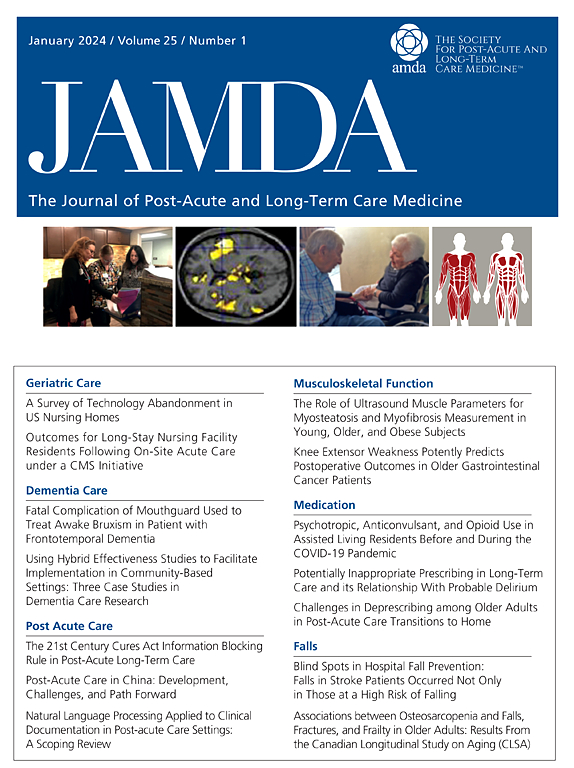瘫痪、非瘫痪和全身相位角对老年脑卒中患者运动能力的影响
IF 4.2
2区 医学
Q2 GERIATRICS & GERONTOLOGY
Journal of the American Medical Directors Association
Pub Date : 2025-05-12
DOI:10.1016/j.jamda.2025.105607
引用次数: 0
摘要
目的研究老年脑卒中患者的相位角(PhA)与体能表现的关系,重点研究下肢相位角(PhA)与康复预后的关系。设计:回顾性队列研究。背景和参与者:日本一家康复医院71例年龄≥65岁的脑卒中患者。方法采用生物电阻抗法测定全身PhA、瘫痪侧下肢PhA和非瘫痪侧下肢PhA。在入院和出院时使用短物理性能电池(SPPB)测试评估身体性能,子域包括平衡、步态速度和椅子上升性能。在调整各种潜在混杂因素后,进行多元回归分析以确定不同pha是否影响出院时SPPB评分。结果较高的非瘫痪侧下肢PhA与患者出院时SPPB评分(β = 0.313, P = 0.004)、平衡能力(β = 0.281, P = 0.016)和起椅能力(β = 0.388, P = 0.004)显著相关。瘫痪侧下肢PhA是总SPPB的预测因子(β = 0.290, P = 0.020),而非瘫痪侧下肢PhA与总SPPB的相关性更大。全身PhA与总SPPB或任何SPPB子项均无相关性。结论和意义下肢PhA,特别是非瘫痪侧PhA,是老年卒中患者身体表现的重要预测指标。下肢瘫痪侧PhA发挥作用,特别是在预测行走能力方面。这些发现表明,位点特异性PhA可能是亚急性脑卒中患者康复计划和预后评估的有价值的生物标志物。本文章由计算机程序翻译,如有差异,请以英文原文为准。
Effects of Paralyzed, Nonparalyzed, and Whole-Body Phase Angle on Physical Performance in Older Patients with Stroke
Objectives
This study investigated the association between phase angle (PhA) and physical performance in older patients with stroke, focusing on lower-limb PhA and predicting rehabilitation outcomes.
Design
A retrospective cohort study.
Setting and Participants
Seventy-one patients with stroke aged ≥65 years at a Japanese rehabilitation hospital.
Methods
Bioelectrical impedance analysis was used to measure whole-body PhA, paralyzed side lower-limb PhA, and nonparalyzed side lower-limb PhA. Physical performance was assessed using the Short Physical Performance Battery (SPPB) test at admission and discharge, with subdomains including balance, gait speed, and chair-rise performance. Multiple regression analysis was performed to determine whether different PhAs affected SPPB scores at discharge after adjusting for various potential confounders.
Results
Higher nonparalyzed side lower-limb PhA were significantly associated with better SPPB scores at discharge (β = 0.313, P = .004), and improved balance (β = 0.281, P = .016) and chair-rise performance (β = 0.388, P = .004). Paralyzed side lower-limb PhA was a predictor of total SPPB (β = 0.290, P = .020), but nonparalyzed side lower-limb PhA was more associated with total SPPB. Whole-body PhA was not associated with either total SPPB or any of the SPPB subitems.
Conclusions and Implications
Lower-limb PhA, particularly on the nonparalyzed side, is a significant predictor of physical performance in older patients with stroke. Paralyzed side lower-limb PhA plays a role, particularly in predicting walking ability. These findings suggest that site-specific PhA may represent valuable biomarkers for rehabilitation planning and prognostic assessment in patients recovering from subacute stroke events.
求助全文
通过发布文献求助,成功后即可免费获取论文全文。
去求助
来源期刊
CiteScore
11.10
自引率
6.60%
发文量
472
审稿时长
44 days
期刊介绍:
JAMDA, the official journal of AMDA - The Society for Post-Acute and Long-Term Care Medicine, is a leading peer-reviewed publication that offers practical information and research geared towards healthcare professionals in the post-acute and long-term care fields. It is also a valuable resource for policy-makers, organizational leaders, educators, and advocates.
The journal provides essential information for various healthcare professionals such as medical directors, attending physicians, nurses, consultant pharmacists, geriatric psychiatrists, nurse practitioners, physician assistants, physical and occupational therapists, social workers, and others involved in providing, overseeing, and promoting quality

 求助内容:
求助内容: 应助结果提醒方式:
应助结果提醒方式:


